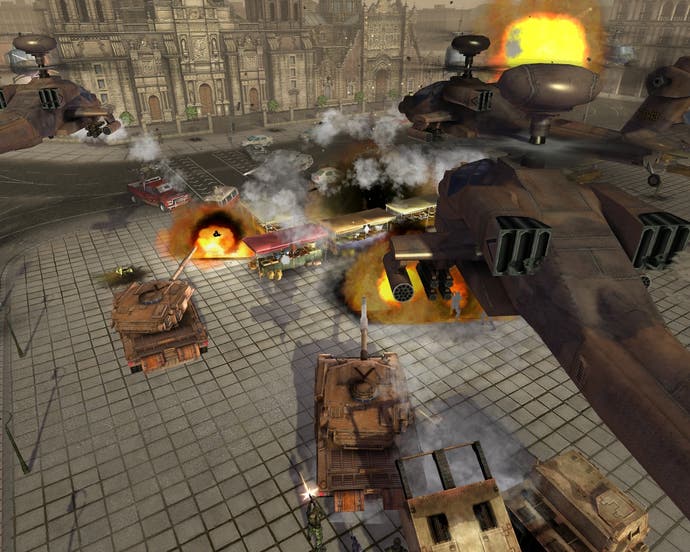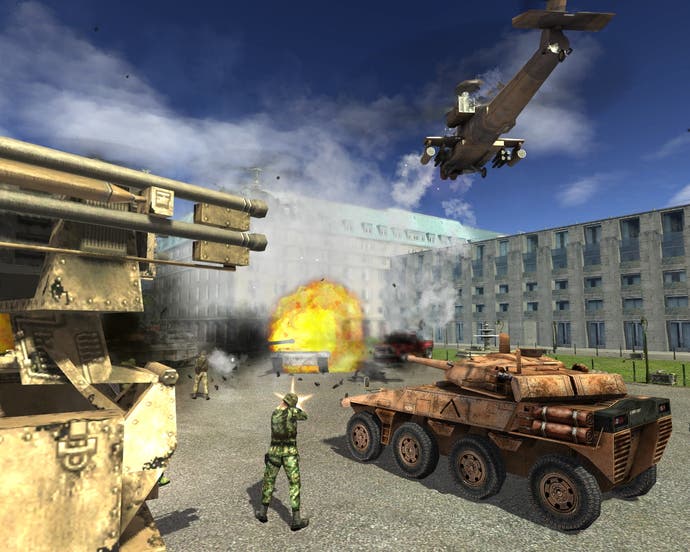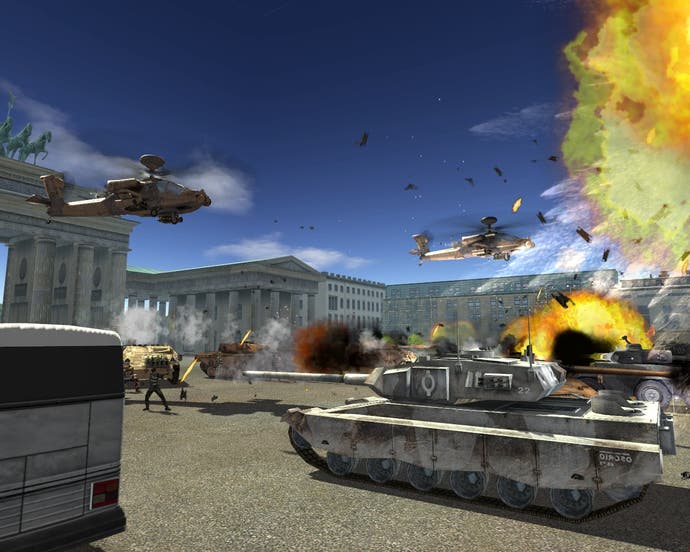The War on Terror
The war on the War on Terror.
Videogames never cease to surprise. If before playing this you asked me to bet what I thought my introduction would contain, I'd have put serious money on some manner of the usual leftist pinko Guardian reading nonsense that Walker and I end up crowbaring into our reviews much to everyone's embarrassment. Evens odds on it featuring the line "We'll stop putting politics into our reviews when developers stop putting politics into their games". But no.
Heavens above: tastelessness is the least of the War on Terror's problems.
Despite its 'torn from the headlines' name, it's not particularly weighted in the real world. It offers three sides to play on and a campaign of each to play through. That is, the World Forces (i.e. America and chums), The Order (i.e. non-threateningly unspecific group of Terrorists) and China (i.e. China). Its key design points are based around a lack of base building; capture flags and you can call in reinforcements. Also, while the politics are fantasy, the game - like Deus Ex - takes pleasure in setting its conflicts in recognisable locations. Let's use the training level for an example, as i) It's actually an impressively accurate visual simulacra of Alcatraz Island and ii) It's the only one I played.
Bear with me.

Immediately you're overcome with a mass of faults. While the map is detailed, the characters have little or no interest in interacting with it. Those tempting steps up to the building? No, scenery only. At one point, even when there's an obvious clear pathway at least 10ft wide which leads directly to where you want to go, the pathfinding prefers to take the Alcatraz tourist route of the area.
Then you start seeing past the programming faults and realise no-one in the design team had a clue either. The camera wobbles around aimlessly, with a tap of the cursor when fully zoomed out making it lurch far too much to be vaguely controllable. You're introduced to a character's stealth abilities when you're asked to try and sneak past a group of people. "That close?" you think, and then find out it's actually a forced failure. While each soldier has a special ability, the actual combat engagements are utterly meaningless - you click at a far off destination then sit back to let the troops find their own way, killing everyone on the way with no help from you. When finally you get to the hostages you're told you have to clear a way out to avoid risking their lives. Fair enough, but what they actually mean is "Clear every enemy off the island". The level is divided into a long, meandering paths which your foot-soldiers slog around like a bunch of hobbled sloths, leading to excruciatingly annoying backtracking trying to find elusive terrorists. Can't find the last of them, save the game and go and look around online for a solution. There isn't one.

Sighing, I head back into the game and - marvellous! - manage to find one of the errant goits. Hostages march a bit further before the commander says there's some more I have to get rid of before it's safe to leave, despite no enemy of democracy having shown their face in the last twenty minutes or so. Back to the searching - at which point we discover the programmers have got fed up at the bad designers getting all the criticism, and all the holes in the barricades you made during the mission have been magically filled up via the simple process of loading a saved game, rendering the mission uncompletable.
Time to skip into the main campaigns and get on with it... oh dear. You can't play any of the campaigns until you've completed the training mission.
Right.
Had enough of this rubbish. I'm off to play Oblivion some more. 2/10.
No, only joking. Of course I persevere. While I'm not going to humour this team-up of terrible design and terrible programming by wasting another hour on the training level (The troop speed being so slow meaning that even knowing what I'm doing, I wouldn't be able to do it any quicker), I turn my attention to what I can play. Namely the skirmish (and multiplayer) mode itself. Except in very rare RTSs, always the heart of the game anyway.

The game's design thrust becomes more clear, with relatively small sized forces with individual special abilities in tight conflict. However, it very rapidly becomes clear that there's nothing really of note here - or rather, nothing particularly positive of note. Problems seen in the mother game only become worse: for example, the pathfinding. In the smallest of the maps, even the smallest of vehicles refuse to drive across the enormous girder-formed bridge. AI responses are questionable, with troops happy to be bombarded by enemies just outside their firing range. Most aggravatingly, some of the attempts at balancing are painfully obvious. While certain troop types being incapable of firing at other troop types are standard, having certain kinds of helicopter incapable of meaningfully fighting other helicopters is getting a little silly. It's even worse when, if you both play the same of the three sides, the units are virtually indistinguishable, and you can't work out whether you can't shoot someone because it's one of your units or because it's an enemy your unit can't shoot.
Oh - and at the end of the first game I play, as if sensing it needed to go for some kind of grand finale, it crashes.
Right.
Had enough of this rubbish. I'm off to play Oblivion some more. 2/10.
Some will say I should have played this more.
To be honest though, I wish there were some way I could have arranged - perhaps by a magic boon with a friendly fairy or selling my soul to the Daedra - to have played it even less.

